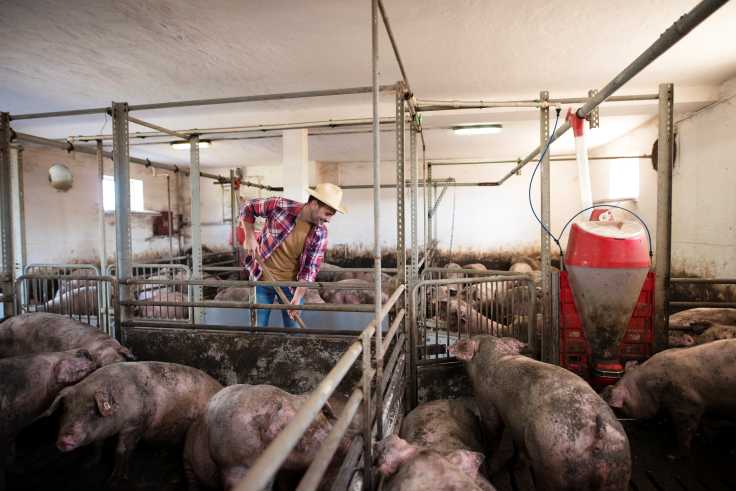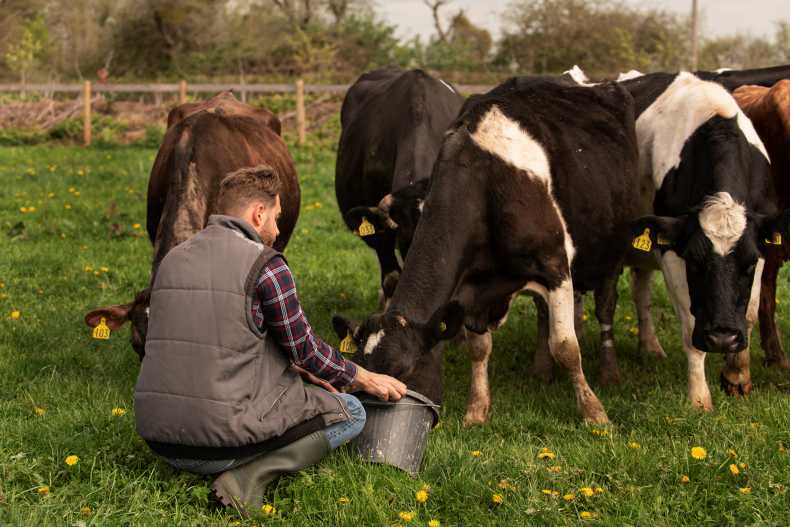
Beginning of 2013 was for the dairy farmers and processors under the sign of bad luck. And so, fears were high at the end of 2012, but market events from January until now had increased the fear of the near future. Some say that more than 30% of the processing companies will be closed by 2015 and that many farms will abolish or they will switch to beef production. So will it be? We shall see. What did we have ... (I) Until then, first to see which was the level of production in 2012. In the absence of other data, the only source is the National Institute of Statistics (NIS). Here are the final data for last year: In December 2012, the amount of cow's milk collected from dairy farms and collecting centers by the processing companies dropped both from the previous month, 0.9%, and compared to December 2011, by 6.0%. In 2012 compared to the previous year, the amount of cow's milk collected from dairy farms and collecting centers by the processing companies decreased by 1.5%. Significant decrease in production in December 2012 compared with November 2012, was registered for acidified milk (yoghurt, drinking yoghurt, sour milk, etc.) by 2024 tones (-16.1%). Among major dairy products, the biggest increase in production in December 2012, compared to the previous month, may be referred to butter, with 166 tones (19.8%) followed by cheese, including cheese obtained exclusively from cow's milk (93.1% of the total production of cheese) with 225 tons (+4.5%), by drinkable milk with 148 tons (+0.8%) and sour cream with 26 tons (+0.6% ). Compared to December 2011, in December 2012, the amount of cow's milk collected by the processing units decreased by 3,984 tones (-6.0%). The production of drinking milk decreased in December 2012 with 584 tones (-3.1%) and production of butter has remained fairly constant compared to the corresponding month of 2011. Increases in production in December 2012 compared to December 2011 registered for: cheese, including cheese obtained exclusively from cow's milk by 797 tones (+17.8%), sour cream by 161 tons (+3.6%) and acidified milk (yoghurt, drinking yoghurt, sour milk and others) with 297 tons (+2.9%). In 2012 compared to the previous year, the amount of cow's milk collected by processing units decreased by 13,638 tons (-1.5%). In 2012 compared with 2011, production decreased at: drinking milk with 11,475 tons (-5.2%) and butter with 162 tons (-1.7%). Increases in production in 2012 compared with the previous year may be referred to: cheese, including the amount of cheese obtained exclusively from cow's milk (89.4% of total production of cheese) with 4,596 tons (+7.4%), acidified milk (yoghurt, drinking yoghurt and others) with 6,011 tons (+4.1%) and sour cream with 431 tons (+0.9%). The production of sheep milk does not appear in the Statistics, this belonging more to the sheep breeding area, and why not to say, to the gray area of dairy business. The above level of production was achieved at a level of 1.222 million cattle heads, according to the same NIS. We emphasize, however, that industry specialists sustain two more numbers: 920,000 and approximately 850,000 heads!What did we have...(II) We think it is also interesting to see the top of dairy processors, according to the turnover. As we have no data available for 2012, here is the top of 20 first processors, the data being communicated to us by the Ministry of Finance: 1- Danone: 502.557.254 lei (594 employees) 2- Friesland-Campina: 382.720.738 (617) 3- Albalact: 353.247.148 (631) 4- Napolact: 222.374.148 (373) 5- Hochland: 197.954.114 (312) 6- Dorna Lactate: 185.200.945 (357) 7- Simultan: 127.754.068 (158) 8- Dorna SA: 104.414.981 (236) 9- Olympus: 97.112.904 (120) 10-Covalact: 90.434.113 (371) 11-Carmo-Lact Prod: 47.831.233 (196) 12-Almera: 44.494.711 (145) 13-Gordon: 42.664.986 (158) 14-Primulact: 42.015.624 (226) 15-Teletext: 36.559.017 (142) 16-Indolact: 35.225.706 (36!) 17-Rarăul: 34.541.901 (157) 18-Lactate Natura: 32.541.901 (170) 19-Nordex: 30.203.285 (25) 20-Solomonescu: 29.231.999 (145) No data available showing profitability rate of individual companies but we are sure that, for many, things are not too rosy, and the above figures may be misleading. ...and what did we loose Well, the primary production sector continued to lose herds. Last year's drought has determined many farmers to slaughter many cows. In addition, 1 January 2015 begins to persuade many farmers to give up the business, or the conversion to beef production, in the hope that it will be more successful. When referring to subsistence farming, there were greater losses. For many farmers, keeping a cow has become a big problem, a lot of them abandoning the business. Then, another year was lost, thinking in terms of setting up OIPA! Although April ( The Romanian Dairy Industry Association) is fervent supporter of the idea, and there is support from Romanian Minister of Agriculture (MADR), when it comes to sit down and put it together with farmers, everything remains at a fishtail that will open and through its wings will come increasingly more raw milk, from imports. And, if we talked about the imports, let's mention what the processors had lost. The first and most important thing lost is the war with the retail. However, as they have been positioned since the beginning, in relation to the hypermarkets, companies do not have anyone else to complain than their sales departments. Now, the domestic processors watch how the hypermarkets provide increasingly more private label dairy products, mostly from import, and if we talk about private label, some companies watch how they self-compete on the shelf: on a shelf part, private label dairy products produced in their own factory, and nearby, the product with the company brand, more expensive. Then, amid a sharp fall in purchasing power, reduction which will increase in the near future, together with the VAT which remains at 24%, processors see how their market share drop dramatically. Another loss was caused by massive market entry in Romania by foreign milk suppliers for the school program "Croissant and milk." Unable to compete on price with Sole Mizo, for example, led to numerous contracts lost in favor of Hungarian companies. Moreover, if we consider how many scandals about milk quality provided in the kindergartens and schools, scandals which our editorial team maintained discretion, from respect to our local processors, we still have reason to think that the losses for Romanian processors, on this business segment, will increase. Unfortunately, for the true-born investors, there are not too many solutions for exit the crisis. If, multinationals operating in Romania have the ability to support repositioning, assortment restructuring, rebranding or, simply crisis milestones, a 100% Romanian processor is more limited in this respect. What will be? The answer can not be given accurately, but, we give few opinions. In the analysis from the section "International" to this edition of the magazine, you may notice the zonal strategy of multinationals and you can make an image of the dairy industry in Romania, compared to the former Yugoslavia, Bulgaria and Hungary, countries which, however, move better than us. As far as we are concerned, things involves two aspects: production and processing. So: If farmers do not invest quickly in order produce good milk at a competitive price, many will exit the market and that, from this year. However, we suspect herds reduction and production decrease, especially that at the national level, has not yet been devised a strategy to mitigate the impact of 2015. More than that: we do not dare to mention about the association of farmers for processing, not just production, as recommended by the European Union, which would maintain them at the surface and could turn them, in the near future, in redoubtable local players, like in the Western countries. Because we went into the processing area, let's strengthen the view that the Romanian companies will be in difficult situation. However, we will see an increase in offensive of retail, import and also to a big increase of market seizure by the multinationals. It is possible that some companies to limit production, focusing on premium products, trying a shy export. But, the business value, therefore, will be much diminished. Otherwise, there are not excluded insolvencies, takeovers, bankruptcies. The European Parliament recommendations for 2013-2014 Recognizing the difficulty of the moment, since last year, the European Parliament made several recommendations contained in EC Regulation no. 1234/2007, updated in 2012, which gleaned the hope that the information will be read again by those who are entitled to draw up a national strategy: "Successive reforms of the organization of a common milk and dairy market aimed at encouraging market orientation, namely, encouraging farmers to guide regarding the nature and volume of their production according to price signals. (...) Lately, there were exceptional developments in the milk and dairy product markets. The financial and economic crisis has negatively affected dairy producers in the Union. The increase in raw material prices caused a significant increase in the cost of feed and production costs, including energy. Subsequently, a decrease in global demand led to a fall in prices in the Union, to the lowest level of the safety net. In response to the difficult situation of the milk market was constituted a High Level Expert Group ("HLG"), in order to examine the relevant provisions for milk and dairy products, in the medium and long run, which in the context of milk quota abolition, scheduled for 2015, would help stabilize the market. HLG noted that dairy production and processing sectors are very different from one member state to another. It appears also varied situations between operators and types of operators within each member state. However, in many cases, the concentration of demand is low, leading to an imbalance of bargaining power in the supply chain between farmers and manufacturers of dairy products. This imbalance can lead to unfair trade practices. In particular, farmers may not know in the moment of delivery the price you will receive for their milk, because price is often fixed much later by dairies, based on the added value obtained, on which farmers often have no influence. There is therefore a matter of the price distribution on the entire chain, which mainly affects farm-gate prices, which generally do not increase in proportion of production costs ever higher. On the other hand, milk supply has not adapted quickly to falling demand. Value added in the dairy supply chain increasingly focused on downstream sectors, and especially for dairies and retailers, the price paid by the final consumer is not reflected by the price paid to milk producers . All actors in the dairy supply chain, including distribution sector should be encouraged to address these imbalances. In the case of dairies, the quantity of milk that is delivered during season is not always well planned. Even in the case of dairy products factories established in dairy cooperatives, there is a possibility of impaired adaptation to demand: farmers are obliged to deliver their entire quantity of milk to their cooperative, and this is obliged to accept all that milk. The use of written contracts that meet certain formal requirements, completed before delivery containing basic elements is less widespread. However, such contracts could contribute to strengthening the responsibility of the dairy chain operators and avoid certain unfair trade practices. In the absence of a regulation at the EU level regarding these contracts, member states have the possibility, within their own contract law, to impose the conclusion of such agreements, with the condition of respecting the EU law, notably regarding the proper functioning of the internal market and the common market organization. Given the diversity of situations that exist in contract law in the EU, indicated that, in the interests of subsidiarity, such a decision to be left to member states. It should be mandatory equal conditions to all deliveries of raw milk in a given territory. Consequently, if a member state establishes that any supply of raw milk in its territory, done by a farmer to a processor, must be based on a written contract between the parties, this obligation should also apply to deliveries of raw milk from other member states, but is not required to be applied for deliveries to other member states. In accordance with the principle of subsidiarity, member states should be the ones to decide if they request to the first buyer a written offer to a farmer, to deal such a contract. "



